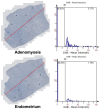Eutopic and Ectopic Endometrial Interleukin-17 and Interleukin-17 Receptor Expression at the Endometrial-Myometrial Interface in Women with Adenomyosis: Possible Pathophysiology Implications
- PMID: 39456936
- PMCID: PMC11508639
- DOI: 10.3390/ijms252011155
Eutopic and Ectopic Endometrial Interleukin-17 and Interleukin-17 Receptor Expression at the Endometrial-Myometrial Interface in Women with Adenomyosis: Possible Pathophysiology Implications
Abstract
Adenomyosis involves the infiltration of endometrial glands and stroma deep into the uterine tissue, causing disruption to the endometrial-myometrial interface (EMI). The role of interleukin-17 (IL-17) has been extensively studied in endometriosis, but its involvement in adenomyosis remains unclear. This study aimed to investigate the expression of IL-17 in eutopic and ectopic endometrium (adenomyosis) of individuals with adenomyosis at the level of EMI. Paired tissues of eutopic endometrium and adenomyoma were collected from 16 premenopausal women undergoing hysterectomy due to adenomyosis. The IL-17 system was demonstrated in paired tissue samples at the level of EMI by the immunochemistry study. Gene expression levels of IL-17A and IL-17 receptor (IL-17R) were assessed through quantitative real-time reverse transcription polymerase chain reaction (RT-PCR). Comparative gene transcript amounts were calculated using the delta-delta Ct method. By immunohistochemical staining, CD4, IL-17A, and IL-17R proteins were detected in both eutopic endometrium and adenomyosis at the level of EMI. IL-17A and IL-17R were expressed mainly in the glandular cells, and the expression of both IL-17A and IL-17R was found to be stronger in adenomyosis than in endometrium. 3-Diaminobenzidine (DAB) staining revealed greater IL-17A expression in adenomyosis compared to eutopic endometrium. Quantitative RT-PCR showed 7.28-fold change of IL-17A and 1.99-fold change of IL-17R, and the fold change level of both IL-17A and IL-17R is significantly higher in adenomyosis (IL-17A: p = 0.047, IL-17R: p = 0.027) versus eutopic endometrium. We found significantly higher IL-17 levels in adenomyosis compared to eutopic endometrium at the level of EMI. The results showed that the IL-17 system may play a role in adenomyosis.
Keywords: adenomyosis; cytokine; endometrial–myometrial interface; interleukin-17.
Conflict of interest statement
The authors declare no conflicts of interest.
Figures




References
MeSH terms
Substances
Grants and funding
LinkOut - more resources
Full Text Sources
Research Materials

